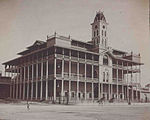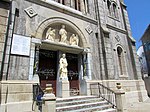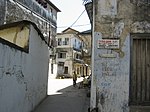
Zanzibar is a semi-autonomous region of Tanzania. It is composed of the Zanzibar Archipelago in the Indian Ocean, 25–50 kilometres (16–31 mi) off the coast of the mainland, and consists of many small islands and two large ones: Unguja and Pemba Island. The capital is Zanzibar City, located on the island of Unguja. Its historic centre is Stone Town, which is a World Heritage Site.
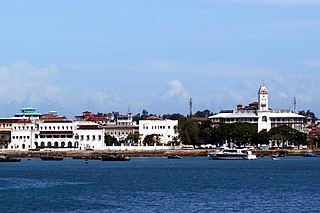
Stone Town of Zanzibar, also known as Mji Mkongwe, is the old part of Zanzibar City, the main city of Zanzibar, in Tanzania. The newer portion of the city is known as Ng'ambo, Swahili for 'the other side'. Stone Town is located on the western coast of Unguja, the main island of the Zanzibar Archipelago. Former capital of the Zanzibar Sultanate, and flourishing centre of the spice trade as well as the slave trade in the 19th century, it retained its importance as the main city of Zanzibar during the period of the British protectorate. When Tanganyika and Zanzibar joined each other to form the United Republic of Tanzania, Zanzibar kept a semi-autonomous status, with Stone Town as its local government seat.

Tourism is a major industry in Croatia. In 2018, Croatia had 19.7 million tourist visitors who made 110.275 million overnight stays. The history of tourism in Croatia dates back to the middle of the 19th century in the period around 1850. It has been developing successfully ever since. Today, Croatia is one of the most visited tourist destinations in the Mediterranean.

Lamu or Lamu Town is a small town on Lamu Island, which in turn is a part of the Lamu Archipelago in Kenya. Situated 341 kilometres (212 mi) by road northeast of Mombasa that ends at Mokowe Jetty, from where the sea channel has to be crossed to reach Lamu Island. It is the headquarters of Lamu County and a UNESCO World Heritage site.
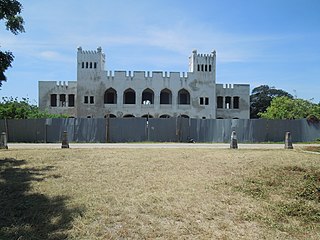
Bagamoyo, Tanzania, is a town founded at the end of the 18th century, though it is an extension of a much older settlement, Kaole. It was the capital of German East Africa and was one of the most important trading ports along the East African coast along the west of the Indian Ocean. In 2011, the town had 82,578 inhabitants and is the capital of the Bagamoyo District.
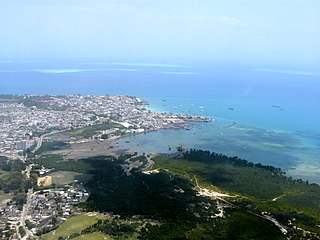
Zanzibar City is the capital and largest city of Zanzibar, in Tanzania. It is located on the west coast of Unguja, the main island of the Zanzibar Archipelago, roughly due north of Dar es Salaam across the Zanzibar Channel. It also serves as the capital of the Zanzibar Urban/West Region, and qualifies as a district, formally known as Zanzibar Urban District. In 2002 its population was 205,870.

Tanzania is a country with many tourist attractions. Approximately 38 percent of Tanzania's land area is set aside in protected areas for conservation. There are 17 national parks, 29 game reserves, 40 controlled conservation areas and marine parks. Tanzania is also home to Mount Kilimanjaro, the highest point in Africa.

Jozani is a village on the Tanzanian island of Unguja. It is located in the southeast of the island, 3.1 miles south of Chwaka Bay, close to the edge of the Jozani-Chwaka Bay National Park. It is primarily a farming community of about 800 people. located 21.7 miles south-east of Zanzibar Town off the road leading to Paje, Zanzibar. It is easily reached by public buses 309 and 310, by chartered taxi or as an organized tour from Zanzibar Town. These tours are often in combination with dolphin observation in Kizimkazi, one of Zanzibar’s oldest settlements with a tiny 12th century mosque open to public. The main road on the island, connecting the west and east coasts of Zanzibar, also connects to Jozani. Besides public bus routes 9, 10 and 13, you can also get here from Zanzibar Town by dala-dala number 309, 310, 324, and 326. Jozani is a small and rural village, situated in the innermost part of the Pete Inlet Bay, immediately south of the Jozani Chwaka Bay National Park. It is one of six rural villages surrounding the park. Residents here depend to a large degree on the Jozani Forest as a source of firewood, hunting, building resources, farming, fishing, and more. The village also operates ecotourism in the Jozani Forest and has constructed a 0.6 mile boardwalk through the mangroves at the southern road entrance into the national park. Many villagers work as authorized guides for tours in the southern tip of Jozani Forest.
The Mwela Rock Paintings are a national monument of Zambia, about 4.8 kilometers (3.0 mi) east of Kasama

Shetani are spirits of East African mythology and popular belief. Mostly malevolent, and found in many different forms and different types with different powers, shetani are a popular subject of carved artwork, especially by the Makonde people of Tanzania, Mozambique, and Kenya. Physically, shetani of various types appear as distorted human and animal figures.

Uroa, sometimes spelled Urowa, is a small, rural coastal village on central eastern parts of Unguja in Tanzania. It is situated in the Chwaka Constituency in the Unguja South Region. It is located in the Uroa Bay, approximately halfway between the villages of Kiwengwa and Chwaka; 21.7 miles (35 km) north of Zanzibar Town. It is located 5.6 miles (9 km) north of Chwaka and 7.1 miles (11.5 km) south of Kiwengwa. Uroans mostly live on fishing and seaweed farming; tourism is also developing in the area, although to a lesser extent than on the south-eastern coast around Jambiani. It is a small and centerless village with resorts on the southern and northern side of its bay. It is home to only six stores and is recognized as a traditional, slow-paced, and spread-out village. Uroa Village stretches in a narrow, long line from south to north along the coastline, appropriately named Uroa Beach. The elevation of the town is only 3.2 feet on average. Its economy has traditionally relied on fishing and seaweed collecting, but has since 2008 experienced a growth in tourist accommodation. In addition, recent years have also seen an increase in governmental jobs such as health workers, administrators and teachers. New sources of income have contributed to an increased median income for Uroans, however, the income is fairly unequally distributed. For instance, the monthly income for seaweed farmers represent only U.S. $7 per farmer, while Uroans working in the tourist industry makes U.S. $65 on average per month.

Nungwi, or Ras Nungwi, is a large village located in the far northern end of the island of Zanzibar. With a population of about 5,563, Nungwi is the second- or third-largest settlement on the island, possibly smaller than Makunduchi. It is situated in the Nungwi Ward in the Kaskazini A District of the Unguja North Region. It is about 35 miles (56 km) north of Zanzibar Town on the Nungwi Peninsula, about an hour drive from Stone Town. To the south Nungwi shares a border with the neighboring Matemwe- and Tazari villages. Nungwi was traditionally a fishing village and dhow-building center, but is now a popular tourist destination, and for instance recognized in CNN’s list of "100 best beaches of the world" in 2014. West Nungwi has changed a lot since the 1990s and is now a popular tourist destination with numerous resorts, restaurants, bars, stores, etc. East Nungwi is quieter and generally more laid-back.

The Sultan's Palace, Bait As-Sahel was destroyed in the Anglo Zanzibar war of 1896, is one of the main historical buildings of Stone Town, Zanzibar, Tanzania. It is a 3-story building with merlon-decorated white walls, located in Mizingani Road, on the seafront, between the House of Wonders and the Old Dispensary.

Tippu Tip's House is a historical building in Stone Town, Zanzibar, located in Suicide Alley in the Shangani ward near the Africa House Hotel and Serena Inn, about 15–25 minute walking time from the Old Fort and Forodhani Gardens. It is the house where the powerful merchant and slave trader Tippu Tip (1837-1905) lived. The building was a private residence until the Zanzibar Revolution, and was later converted into a block of flats. Despite being a tourist attraction, it is not formally open to visitors and it is in such a state of decay that it has been described as "the most magnificent squat in all of Africa". The large decorated carved wooden door, as well as the black and white marble steps, still testify the great wealth of the historical owner of the house.

Malindi Mosque is a mosque in Stone Town, Zanzibar, Tanzania, located near the port. It is one of the oldest mosques in Zanzibar, dated to the 15th century. It was built by Sunni Muslims and it has some unusual architectural features, including a cone-shaped minaret and a square platform.
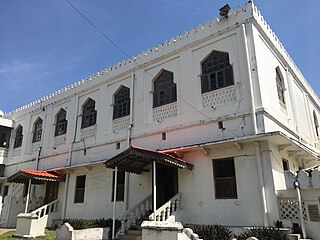
Ijumaa Mosque is a mosque in Stone Town, Zanzibar, Tanzania. The mosque was completely renovated in 1994 in the modern arabesque style.
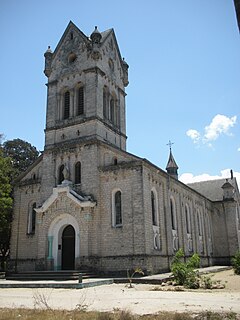
Holy Ghost Mission is located in Bagamoyo, Tanzania. The pioneer mission was established by the Holy Ghost Fathers. The original Holy Ghost Church, built in 1872, is reportedly the oldest church on the mainland of East Africa, while the new church was built 1910-1914. In 1874, David Livingstone was interred for a night at the Holy Ghost Mission; the Livingstone Tower, a part of the original church, is named in his honor.
The following is a timeline of the history of Zanzibar City, Unguja island, Zanzibar, Tanzania. The city is composed of Ng'ambo and Stone Town. Until recently it was known as Zanzibar Town.
Fatuma binti Yusuf al-Alawi was a queen of Unguja in pre-Sultanate Zanzibar. A supporter of the Portuguese in their war against Oman, she sent supplies to the Europeans at the Siege of Fort Jesus. She was captured during the subsequent Omani occupation of Zanzibar and exiled to Oman. Allowed to return in 1709 she ruled the island as a client state of Oman for the rest of her life.
Zanzibari independence is a political ambition of some political parties, advocacy groups, and individuals of Zanzibar, a semi-autonomous region territory within Tanzania, to become an independent sovereign state.


